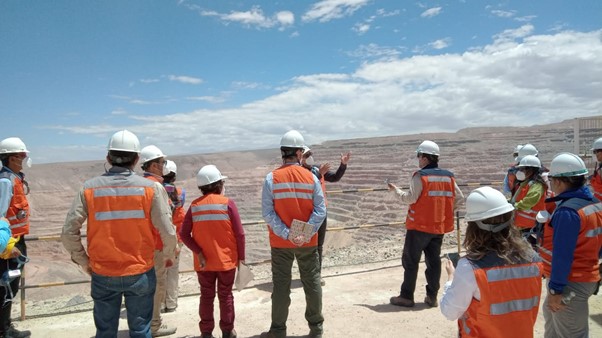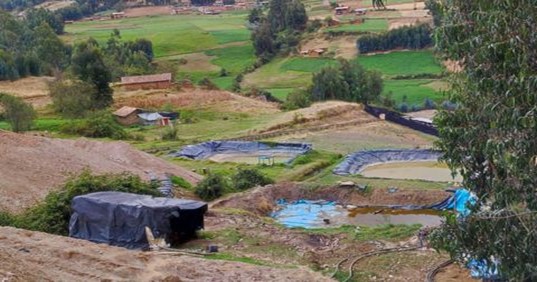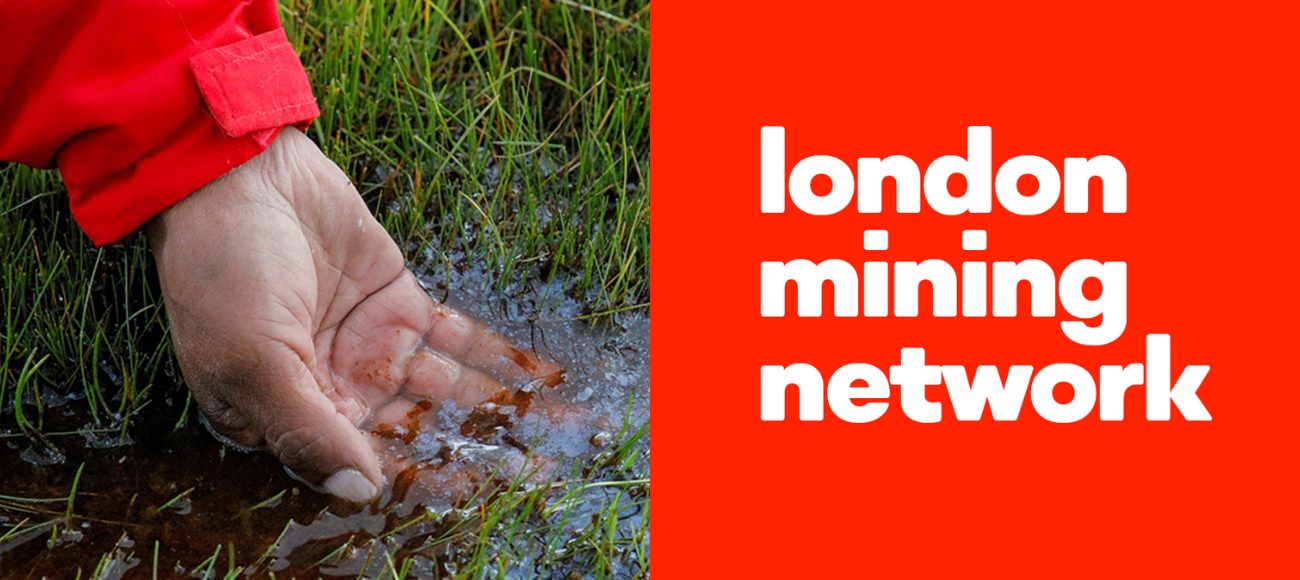This is the latest post in LAB’s London Mining Network blog, a partnership initiative between LAB and LMN. It contains a roundup of Latin America-related content from London Mining Network’s October 2021 newsletter, with additional material supplied by LAB, researched and written by Kinga Harasim.
Chile: BHP is forced to halt operations at the Cerro Colorado mine.
The Antofagasta Environmental Court has issued a precautionary injunction prohibiting Compañía Minera Cerro Colorado (CMCC) from continuing to extract water from the Lagunillas aquifer due to potential environmental damage. The ban will be in effect for 90 days, beginning on 1 October.
The Cerro Colorado Mining Company produces high purity copper cathodes and is located 4.5 kilometres from the Sabaya sector in the Quipisca ravine, inhabited by Queshua indigenous community, and the mining company is located in the Pozo district.
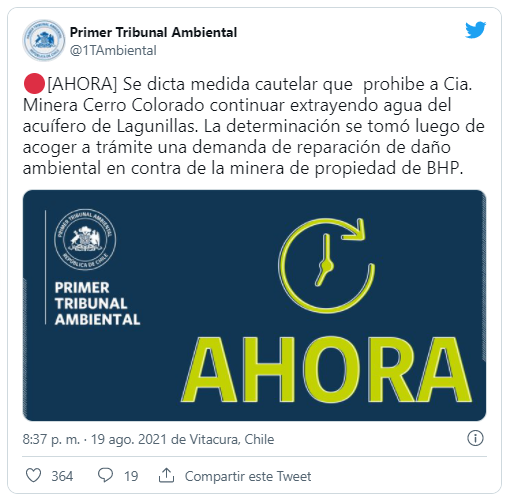
The lawsuit was filed by Luis Eliecer Jara Alarcón, a co-owner of Estancia Cancosa, located within limits of the Salar Lagunillas, which includes the Pampa Lagunillas aquifer, Lagunillas Wetland, and the Huantija Lagoon.
Mining beyond the law
Jara claims that the company draws water from the Lagunillas aquifier to mine copper, ‘without adequate mitigation, repair, and compensation measures’, and has harmed aquifer, lagoon, and wetland.
As well as lacking an environmental permit, [RCA (Environmental Qualification Resolution) 69/2015 was revoked in 2015], CMCC also failed to obtain the required permit for water use from the General Water Directorate (DGA).
‘I own 25 per cent of Hacienda Cancosa,’ says Luis Jara, ‘where the company has more than 40 wells and only four of them are authorized … I am not opposed to mineral extraction, but it should be done with water from another source.’ This is the property of all Chileans, he emphasizes. It is fresh water in the world’s driest region. ‘It should be protected, but no one cares.’
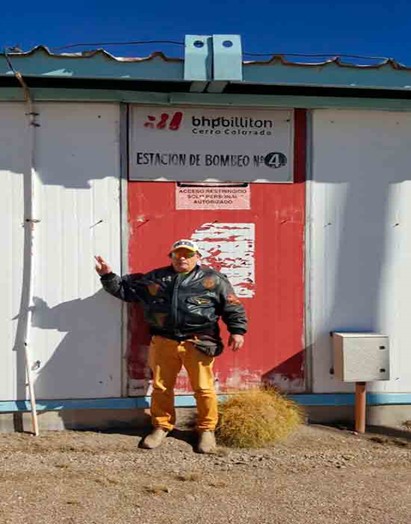
Luis Jara in front of the water pumping station. Image: The Clinic
Since 2015 Jara, with an alliance of indigenous people, has presented various claims against the company. Wetlands in the Tarapacá and Antofagasta regions have been protected by Chilean legislation since 1997, thanks to DGA resolution 909 which established restrictions on water extraction because it ‘sustains unique and fragile ecosystems that it is necessary to conserve and preserve’. Cerro Colorado Mining not only ignored this measure but was planning further expansion of the mine.
In the midst of this conflict, BHP is applying for an environmental permit, allowing it to continue operations until 2023, and only at the last moment filed an addendum containing additional commitments to water resource management.
In response to the injunction, Minera Cerro Colorado filed a 67-page brief with the court on 26 August, claiming that the measure is ‘evidently disproportionate’. ‘We ask to modify the precautionary measure decreed,’ they stated, ‘replacing it instead with a reduction in the pumping of flows for production purposes for a period of 90 days or until the evaluating authority issues a favourable technical ruling that provides assurance that the protected assets are not affected.’
Cerro Colorado has been carrying out detailed studies and hydro-geological models that guarantee, according to Manuel Álvarez, Cerro Colorado’s water affairs superintendent, that ‘at the current rate of extraction, taking into account the effects of climate change in the highlands and also considering the mine’s cessation of operations in 2023, the situation in the aquifers will be reversed and they will recover their levels towards the year 2050, or even earlier.’
However Ladislao Alex Quevedo, the plaintiff’s lawyer, argued for the injunction to be upheld, as there are well established grounds for fearing the almost complete destruction of the aquifer, given the absence of control over water levels in the wetland since April 2018 and the neglect of the monitoring required by the authorities.
The plaintiffs also demand that the company create a new extraction plan that is respects the environment and repairs and restores the damage caused by the extraction of biological resources.
Nevertheless, the court recently decided that for a period of 90 calendar days, the company could extract up to 54 litres of water per second for production.
‘Once that period expires if the mine does not have the approval for its environmental plan, the mining company will not continue to extract water,’ the court ruled.
Peru: Massive Protest against mining in Huamachuco
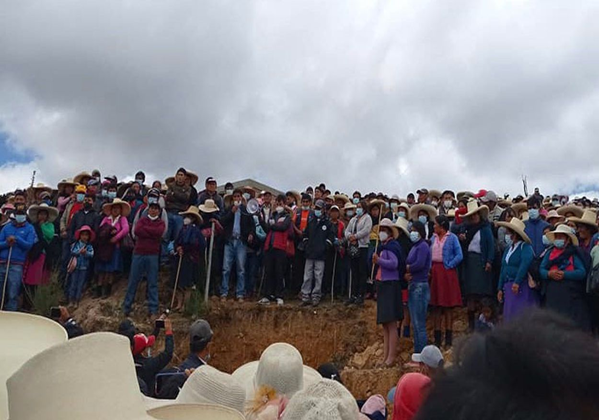
On 15 September, peasants from various districts in Huamachuco, Sanchez Carrión province, La Libertad region, summoned by the Coordinator of the Association of Water and Sanitation Administration Boards (JAAS), staged a massive protest against mining in the province.
‘It is the first time that thousands of citizens have been seen standing up to raise their voices in protest, marking a turning point in the face of destructive mining.’ – said Maritza Monzón, a member of Volunteers for Conservation organization.
Protesters are outraged at the granting of an official permit for mining exploration in the hamlets of Paranshique, Quinta Alta, and Molino Grande, located around the Huaylillas hill, on whose slopes is communities’ main source of water resources, the Cushuro lagoon.
The district has already suffered from water shortages. In a public statement, The Tribune of José Faustino Sánchez Carrión association stressed the importance of the Cushuro lake.
‘We categorically reject the extension of any formal, informal or illegal mining project to the area of the Huaylillas peak, as it is the only space that stores our water reserves for present and future generations and because it directly affects the water for human consumption of thousands of Huamachucan families,’ reads the statement.
The surge of illegal mining
Communities in the area have already had to deal with rampant illegal mining, which has resulted in widespread social and environmental damage, such as the destruction of local water supply channels, cracks in houses and educational centres caused by explosions, with the risk of collapse, as well as physical and mental harm to local residents.
‘This situation has caused minors to suffer eye problems, the death of animals due to the consumption of contaminated water and even persecution of community members with criminal complaints to seize their land.’ – said Jennifer Catalán, the regional councillor of La Libertad.
Illegal mines in Cerro El Toro, Peru. Image: Difusión
The Transitory Provincial Prosecutor’s Office, in collaboration with the Peruvian National Police, have recently intervened in nine illegal mining camps in the region. They discovered 34 cyanidation pools, 700 bags filled with ore, 220 meters of steel cable, 30 bags of lime, five collection points, five crusher motors, five crushers, and other materials used in this illegal activity, which continues to grow out of control.
Residents affected by illegal mining have challenged Prosecutor Laste Acua Raza of the La Libertad Regional Prosecutor’s Office, and Regional Councillor Jennifer Catalán who, they claim, have shown manifest indifference to the situation, denying any problem with illegal mining in the area.
‘In Huamachuco alone, illegal mining generates about 100 million Soles. With this, they buy consciences, cover-ups and the silence of the authorities. There are official regional authorities supporting marches that mostly involve people linked to illegal mining in the area. How is it possible that authorities are protecting, covering up people linked to illegal mining?’ asked Quiroz Díaz, the president of the Regional Council of La Libertad.
Formal mining as an excuse to eradicate illegal mining
Residents claim that, despite multiple requests for the state to intervene, not only has the problem not been resolved, but that some authorities and leaders of the Paranquishe community have granted permits to the mining company Los Andes Peru – a subsidiary of Summa Gold, which is already exploiting mines at Cerro El Toro. In an official letter, seven communities in the district demand that mining companies halt all operations because no social licence has been granted for their polluting activity.
The authorities of the Paranshique hamlet denied allowing mining company work in the area that could affect water resources. They claim to have granted permission for ‘exploration’ work to the Los Andes Peru, but this did not authorise the extraction of minerals.
‘There are no water sources here, so the water resource can’t be affected. All water is from Juan Velasco Alvarado,’ said the municipal agent. – ‘Paranshique was filled with informal mining and cyanidation ponds more than a year ago. The population destroyed all of that; otherwise, we’d be like Shiracmaca, where illegal miners abound. They don’t say anything there, that it affects the water.’
Summa Gold, for its part, has positioned itself, as the cure-all for the province’s illegal mining activity. ‘In Peru we already have a first case of success in the city of Huamachuco (La Libertad), where illegal mining reigned for years in the area of Cerro El Toro. With a new management model, the Peruvian company Summa Gold, based on the legality of its concessions, has recovered and remedied an important part of this territory, turning mining (previously harmful to its environment) into the main economic and social engine of the locality, carrying out clean, productive and socially viable practices.’ – said Francisco Medina Rospigliosi for ProActivo, Manager of Corporate Affairs of Summa Gold Corporation.
In other news…
Mexico: On 9 October, protests against open-pit mining projects in the municipalities of Actopan and Alto Lucero of Veracruze district were reactivated to demand the cancellation of the concessions. Demonstrations erupted after the Canadian company Candelaria Mining, which seeks to extract silver and gold from Cerro La Paila, in Alto Lucero, reported on its website that they plan to resume operations from 31 October. ‘We have read with attention and terror the declarations of the Candelaria Mining company that intends to destroy the mountains of Veracruz to extract gold from the bowels of the earth’ said Guillermo Rodríguez Curiel, a member of the Veracruzana Assembly of Environmental Initiatives and Defense (Lavida).
Brazil: Vale SA announced that it has renounced all mining prospecting rights on indigenous lands in Brazil, acknowledging that they require community consent as well as legal authorisation and regulation. In 2020-21 the company has handed back 89 licences for mineral research and mining activities to the National Mining Agency. ‘Although this decision by Vale came late, it came at a good time. This announcement provides an important message to other companies that still have exploration plans on indigenous lands to abandon them at a time when all global investors are concerned about the criteria,’ Larissa Rodrigues, project director of the NGO Instituto Escolhas, told BNamericas.Argentina: In Andalgalá, children and adolescents have sent an open letter to the president of the nation, Alberto Fernández, expressing their concern about the negative effects of the MARA mining project on the environment and the people. ‘Did you know… that our human rights are being violated? We all have the right to live in a safe and healthy environment! (…) In our town, there is a mining dictatorship. (…) We demand that the machines leave our hill and stop violating our rights, which have been infringed for over ten years!’

